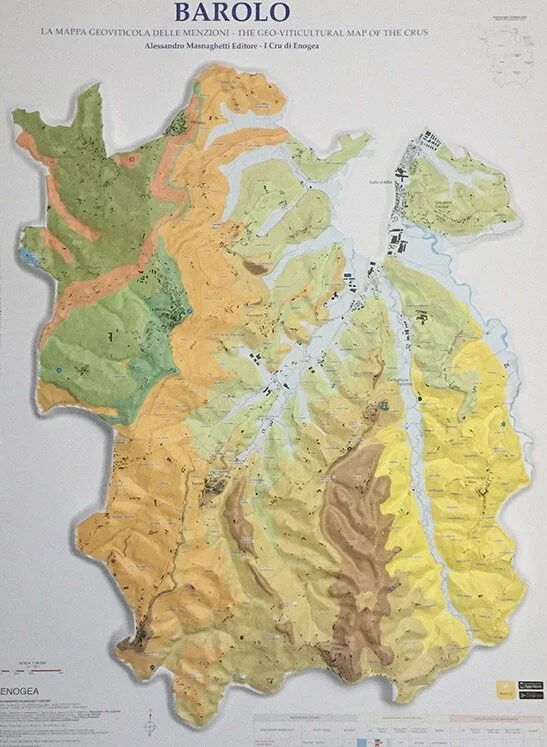The Ultimate Barolo Masterclass - Wine tasting guide to Alba, Barolo
/by Amanda
Intro:
Given the intense nature of the intricate details of Barolo, I have decided to give readers the option of the amount of depth they wish to seek out.
Where there is more information on this post, you will find at the end of the initial explanations to help every reader get the most out of the Barolo area for every level of interest.
The big B. Barolo
Barolo a small wine region just to the west of the town of Alba. This area is made up of 11 villages and takes its name after the Barolo village, located in the heart of the Barolo appellation. While the soil structure of Barolo area is quite complex they can be broken down into 5 distinct types of soils that are associated with their villages and sub-zones.
The 5 main districts:
Serralunga
Castiglione Falletto and Grinzane Cavour
Barolo and Novello
La Morra and Verduno
Monforte
the soil structures of Barolo defined by color.
Origins of soil from rocks: 3 types of rocks are the base of each soil structure making each wine region so unique.
Here is a breakdown of rocks with examples.
igneous rocks
cooled magma (examples granite)
e.g. granite, basalt, dolerite, gabbro, syenite, porphyry
sedimentary rocks - what we find in Barolo, Barbaresco, Langhe
layers of consolidated and cemented sediments, mostly formed in bodies of water (examples limestone, sandstone, conglomerate)
e.g. limestone, sandstone, mudstone, shale, conglomerate
metamorphic rocks
formed by the alteration of existing rocks due to heat from igneous intrusions (examples marble, quartzite) or pressure due to the crustal movement (examples slate, schist).
In the Langhe and specifically in Barolo the soil falls under the Sedimentary rocks, within this category of rocks you will find 3 prehistoric Miocene epoch of soils Serravalliano | Tortonian | Messiniano (and combinations)
Serravalliano - Formazione di Lequio
Tortonian -
1. Arenarie di Diano
2. Marne di S. Agata Fossili Sabbiose
3. Marne di S. Agata Fossili tipiche
4. Marne di S. Agata Fossile laminate
Messiniano - 1. Conlomerati di La Morra
2. Formazione di Cassano Spinola sabbiosa
3. Formazione di Cassano Spinola marnose
4. Formazione della Vena del gesso
Zancleano - Marne Plioceniche
What does all this mean?? To go into depth a bit about the soils and what they do here we go.
The Langhe wine region which encompasses both Barbaresco and Barolo are composed of sedimentary rock. This formation was thanks to the Padano sea which engulfed a large part of the Lower Piedmont region. The sediments eroded from the surrounding areas that were gradually accumulating on the seabed, which in turn buried the older strata. It wasn’t until 12 million years ago did this sea start to reseed and from its movement out left the Langhe with complex soil of the Lequio Formation, Diano Sandstones, and Saint Agata Fossile Marls.
The Lequio Formation: This soilsstructure can be found in the Southern part of Serralunga d’Alba and a part of Monforte d’Alba on the eastern ridge. This formation is the oldest section, marked by light-colored marl, with layers or veins of well-cemented sand.
Diano Sandstone: This soil structure can be found in the highest part of Monforte d’Alba as well as in some areas of La Morra. This soil structure is well noted for its high resistance to erosion because of the well cemented sands.
Sant’Agata Fossil Marl: This complex soil structure changes quite quickly and is the major soil structure throughout all of the Barolo area. These soils comprise mainly fine, silt, and clay sediments making the Barolo area perfect for grape cultivation. There is however some variability to be found, with areas rich in thin veins of sand and others with mainly silt layers.
Barolo Classifications
The best way to think about Barolo now is kind of like the structure of Burgundy. Here in Barolo, we have 4 ways to classify your Barolo.
To become Barolo you need to follow these easy steps:
The vineyards must be located in the boundary of the Barolo wine-producing area. Nebbiolo is the only permitted varietal allowed to be used in Barolo wine and these vines must not be planted on a Northern facing slope. East, West, and South are accepted. The Nebbiolo vines must not exceed 6,000 vines per hectare and the most amount harvested per hectare cannot exceed 56 hL/ha. The minimum aging requirement for Barolo in wood is 18 months, and the wine cannot be released until the 4th January after the harvest. So around 38 months the wine must stay in the cellar before release.
After the 4th January, you must submit your wine for controls, those will consist of analysis to make sure the acidity, Ph, alcohol, and other chemical components are all right. From there, the wine will then also need to pass a sensory analysis, where other producers will get together to test the wine to make sure it is a good example of the region’s best.
From there you then have the classifications system.
Barolo “Classico” - the word “classico” is not a legal term to be used on the label but is used amongst producers and wine enthusiasts to mention a generalization of the Barolo wine. This wine is coming from any of the designated Barolo vineyards and can be a mix of them.
Barolo “Comune” - the village wine. This wine will be coming from the vineyards only located in the specific town which is mentioned on the label. For example Barolo Comune di Serralunga d’Alba, these grapes can only be coming from the town of Serralunga d’Alba.
Barolo “Menzione Geografica Aggiuntiva” - Barolo with a geographical mention. This wine is coming from one small piece of land. For example Barolo Cannubi or Barolo Bussia. From these two names, you know that Barolo is coming from that plot of land.
Barolo “Menzione Geografica Aggiuntiva, Vigna” - Barolo with a geographical mention but a specific plot is being mentioned. Many producers have a special plot in a vineyard that they over the years of cultivation have noticed that there is something special about this area. With that said they decided to vinify and age separately from the rest of that vineyard. When the producer does this you will see a mention of Vigna. For example Barolo Sarmassa Vigna Merenda or Barolo Ginestra Vigna Sorì Ginestra. With this mention of Vigna, the producer must reduce the yield by another 10% in that vineyard to increase even more the quality of the wine.
We should even take the time to talk about Riserva wines. With a Barolo Riserva, all the laws are the same as the Barolo except that you cannot release the wine until the 6th January after the harvest. So it must stay 62 months in the cellar before release. MORE BAROLO WINEMAKING
Cru or Specific Vineyard Sights called Menzione Geografica Aggiuntiva (MGA)
I could go on all day about this chapter as there are 170 single vineyards that make up Barolo. With that I have decided to use the Renato Ratti cru map, I feel as though he took the time to really think about what could be the best possible vineyards for Barolo. He was quite correct in many ways, as many of these vineyards we are going to highlight here are some of the most talked about vineyards in Barolo. They are: Monprivato, Villero, Rocche di Castiglione, Gabutti - Parafada, Lazzarito, Marenca-Rivette, Cannubi, Cerequio, Brunate, and Rocche di Annunziata for the 1st crus. MORE CRUS HERE
Monprivato - Tortoniano Marne di S. Agata Fossili sabbiose
Villero - Tortoniano Marne di S. Agata Fossili sabbiose & Tortoniano Marne di S. Agata Fossili tipiche
Rocche di Castiglione - Tortoniano Marne di S. Agata Fossili sabbiose & Tortoniano Arenarie di Diano
Gabbutti-Parafada - Serravalliano Formazione di Lequio
Lazzarito - Serravalliano Formazione di Lequio
Marenca-Rivette - Serravalliano Formazione di Lequio
Cannubi - Tortoniano Marne di S. Agata Fossili sabbiose & Tortoniano Marne di S. Agata Fossili tipiche & Tortoniano Arenarie di Diano
Cerequio - Tortoniano Marne di S. Agata Fossili tipiche & Tortoniano Marne di S. Agata Fossili laminate
Brunate - Tortoniano Marne di S. Agata Fossili tipiche & Tortoniano Marne di S. Agata Fossili laminate
Rocche di Annunziata - Tortoniano Marne di S. Agata Fossili laminate & Tortoniano Marne di S. Agata Fossili sabbiose & Tortoniano Marne di S. Agata Fossili tipiche









